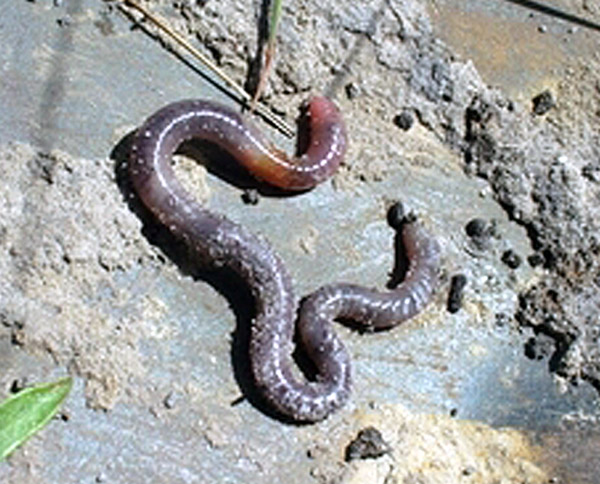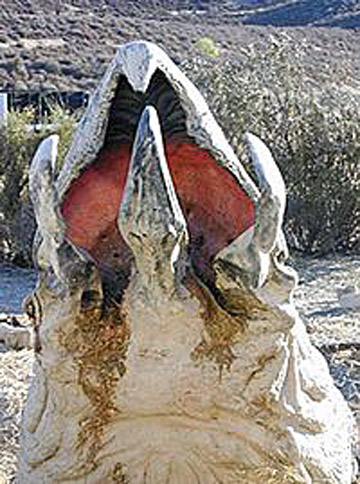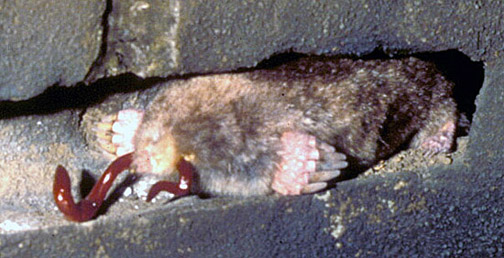In my most recent previous post, I teased readers with the promise of revealing how Charles Darwin used a piano as a scientific tool for studying the behavior of earthworms. Regardless of whether or not you already looked up the answer through The Google, by reading Darwin’s last book (The Formation of Vegetable Mould through the Action of Worms with Observations on Their Habits), or other means, I will now gladly make connections between the seemingly disparate subjects of Darwin’s musically inclined experimentation, earthworm behavior, and fishermen of the southeastern U.S. catching earthworms as bait.
 What makes this earthworm (Diplocardia) run away as fast as its little chetae, mucus, and peristalic movement can carry it through the soil? Let’s just say it’s not picking up good vibrations. Photograph by Bruce A. Snyder, from here, from www.discoverlife.org.
What makes this earthworm (Diplocardia) run away as fast as its little chetae, mucus, and peristalic movement can carry it through the soil? Let’s just say it’s not picking up good vibrations. Photograph by Bruce A. Snyder, from here, from www.discoverlife.org.
In writing about earthworms and their traces in my upcoming book, I devoted several pages to Mr. Darwin’s fascination with earthworms. In this exploration, I tell how Darwin was on to something when he tried applying sound – which included those made by playing musical instruments – to earthworms he had gathered from the English countryside. These musical performances were not an instance of Darwin trying to entertain these worms, boost their self esteem, or otherwise help them get in touch with their emotions. Rather, he was simply testing whether worms reacted to sound. What happened? Well, instead of me describing his results, I’ll let Darwin’s words inform you directly:
Worms do not possess any sense of hearing. They took not the least notice of the shrill notes from a metal whistle, which was repeatedly sounded near them; nor did they of the deepest and loudest tones of a bassoon. They were indifferent to shouts, if care was taken that the breath did not strike them. When placed on a table close to the keys of a piano, which was played as loudly as possible, they remained perfectly quiet.
– Charles Darwin, The Formation of Vegetable Mould through the Action of Worms with Observations on Their Habits (1881), p. 27.
Hence it was with deep appreciation last month when I gazed at the piano in the drawing room of Down House, the former Darwin family home, and thought about these experiments. Smiling, I imagined Darwin carefully watching a container of worms while he or someone else in his family forcefully banged on the keys of this piano. Of course, you also can’t help but wonder what was played “as loudly as possible.” Were these single, random notes, chords, or actual musical compositions? If the last of these, what pieces were played? Ideally, I like to think Mr. Darwin or one of his family members played a sea shanty learned during his days on The Beagle (or perhaps even songs learned from pirates), rather than just pounded random notes up or down a scale.
As conclusive as Darwin’s paragraph might seem about the lack of earthworm reactions to sound, he, like any good storyteller, then injected a dramatic twist when reporting his results. He followed up the preceding paragraph with one describing how earthworms, although deaf, are extremely sensitive to vibrations transmitted through solid media. Here he revealed exactly which notes were played (C on the bass clef, G in the treble clef, C in the treble clef) while two worms were in pots placed on top of the piano.
The vibrations transmitted through solid media – not air – caused the worms to withdraw from the soil surface, presumably hiding from the source of the vibrations. As an extension of this experiment, Darwin also used a fork to agitate the soil underneath other worms, which then provoked them to move up to the surface. Darwin correctly surmised that this stirring activity, like sound, also sent vibrations through the soil, which likewise produced aversive reactions in the earthworms.
These responses made sense in an evolutionary way, and show how Mr. Darwin was applying his principle of natural selection to the predator-prey relationships that had evolved between earthworms and moles. The behaviors he observed would have favored the survival of earthworms that associated vibrations with their most feared predators, and reacting accordingly, which is to say, fleeing in terror. And just what were their aversion-inducing predators? They were not robins or other species of birds – early, punctual, or otherwise timed – but the earthworm version of graboids: burrowing moles.
 Eastern mole (Scalopus aquaticus) emerging from its burrow, seeking earthworms and other fresh food. Photograph by Kenneth Catania, from Fairfax County Schools.
Eastern mole (Scalopus aquaticus) emerging from its burrow, seeking earthworms and other fresh food. Photograph by Kenneth Catania, from Fairfax County Schools.
 Graboid emerging from its burrow, seeking humans and other prey. Note the eerie resemblance of its behavior to that of an eastern mole, albeit orders of magnitude larger and accompanied by a keen interest in large, surface-dwelling, bipedal prey. Photo from Wikipedia, but originally taken from the greatest ichnologically inspired horror film of all time, Tremors.
Graboid emerging from its burrow, seeking humans and other prey. Note the eerie resemblance of its behavior to that of an eastern mole, albeit orders of magnitude larger and accompanied by a keen interest in large, surface-dwelling, bipedal prey. Photo from Wikipedia, but originally taken from the greatest ichnologically inspired horror film of all time, Tremors.
So you didn’t know about graboids, those burrowing predators of the underworld? Fortunately, this educational video provides all of the details you need to know. But if you’re interested in studying their neoichnology, be careful, and stay on the pavement.
As yet another example of ‘backyard science,” Darwin observed many traces of the European mole (Talpa europaea) in the fields just outside Down House, most of which were their mounds, or “molehills.” Indeed, last month as I admired one of Darwin’s original wormstones in the pasture behind Down House, I also noticed a good number of molehills on the grounds. Rather stupidly, I neglected to take a photo of one of these. (I mean, how cool would it have been to share images of the traces of moles that descended from those whose traces Darwin noticed?) Nonetheless, some of my photos of the grassy area near the wormstone show 20-30 cm wide bare patches in this otherwise meticulously maintained lawn. These spots, I suspect, are traces of the Down House groundskeepers, who probably level molehills as quickly as they appear, an ichnological version of “whack a mole.”
 The pasture just behind Down House (Charles Darwin’s former home), with a “wormstone” in the lower right, and a few bare patches of ground just to the left. Could the latter mark recent sites of mole tunnels and molehills leveled by Down House groundskeepers, or are these just places where grass did not grow, and hence the products of an ichnologist’s overactive imagination? Anyway, I did see molehills out there, but don’t blame y’all for being a bunch of skeptical scientists and wanting more evidence than my just saying so.
The pasture just behind Down House (Charles Darwin’s former home), with a “wormstone” in the lower right, and a few bare patches of ground just to the left. Could the latter mark recent sites of mole tunnels and molehills leveled by Down House groundskeepers, or are these just places where grass did not grow, and hence the products of an ichnologist’s overactive imagination? Anyway, I did see molehills out there, but don’t blame y’all for being a bunch of skeptical scientists and wanting more evidence than my just saying so.
OK, now how does all of this wonderfully elucidated Victorian-era science relate to the ecosystems and biota of the southeastern United States? Enter the “worm grunters.” Worm grunters are people who, independently of Darwin, figured out the same adaptive responses of earthworms to underground vibrations. Through their own experiments, worm grunters, who were interested in efficiently gathering many worms in a short time for putting on fishhooks (or making money selling earthworms to people who put them on hooks), rubbed steel slabs across the top of wooden posts stuck in the ground. Much later, researchers interested in finding out how this technique worked calculated frequencies of the seismic vibrations that caused earthworms to flee upward away from perceived predators.
The southeastern U.S., including the Georgia barrier islands, not only has its own species of earthworms (Diplocardia mississippiensis), but also has its own species of moles: the eastern mole (Scalopus aquaticus) and the less common star-nosed mole (Condylura cristata). Both types of moles no doubt strike fear in the multiple hearts of earthworms, and natural selection being how it is, the fastest burrowing moles (who are most likely to catch worms) also cause considerable vibrations from their digging. This accordingly means the earthworms that detect and escape these vibrations live long enough to reproduce and pass on whatever genes that aided in such perceptions.
 In getting caught by this mole, this earthworm may have just won the worm equivalent of a Darwin Award, depending on whether it had reproduced or not. (Which it probably did, considering earthworm hermaphroditism means they are at least twice as likely to get lucky.) Photo from University of Illinois Extension; Home, Yard, and Garden Pests Newsletter, here.
In getting caught by this mole, this earthworm may have just won the worm equivalent of a Darwin Award, depending on whether it had reproduced or not. (Which it probably did, considering earthworm hermaphroditism means they are at least twice as likely to get lucky.) Photo from University of Illinois Extension; Home, Yard, and Garden Pests Newsletter, here.
Thus a visit to Down House in southern England and consideration of Darwin’s contributions to ichnology and behavioral ecology are not so far removed conceptually from the practical knowledge gained by some people in parts of the southeastern U.S. Moreover, many of these same people are of English, Irish, or Scottish descent, and effectively applied the same knowledge surmised by Darwin about worms and moles, which is kind of neat in a heritage sort of way.
Would all of these findings count as applied science, despite its historical lack of Ph.D.-bearing investigators, grant funding, publications, and press conferences announcing the results? Yup. After all, science is about its methods.
So next week, we’ll take a closer look at the traces moles make on the Georgia barrier islands. Do these moles just go after earthworms in the forests and meadows of those islands? Nope. After all, science is not just about its methods, but also surprises.
Further Reading
Darwin, C. 1881. The Formation of Vegetable Mould through the Action of Worms, with Observations on their Habits. John Murray, London, U.K.: 326 p.
Edwards, C.A., and Bohlen, P.J. 1996. Biology and Ecology of Earthworms (3rd Edition). Springer, Berlin: 426 p.
Gorman, M.L., and Stone, R.D. 1990. The Natural History of Moles. University of Chicago Press, Chicago, Illinois: 138 p.
Hendrix, P.F. 1995. Earthworm Ecology and Biogeography in North America. CRC Press, Boca Raton, Florida: 244 p.
Mitra, O., Callaham, M.A., Jr., and Yack, J.E. 2009. Grunting for worms: seismic vibrations cause Diplocardia earthworms to emerge from the soil. Biology Letters, 2009: 16-19.

You and those dang cliffhangers!
Hey, how else am I going to get people to check in and read this blog? Well, yeah, I know, paying them might help, but I’m not quite ready to do that yet.
I know that predator sign. Enjoyed the article. Very enlightening.
All about them vibrations.
You got that right, Arlene. If those earthworms could, they’d change the lyrics of that Beach Boys song to “Bad Vibrations.” Which I suppose would be a form of decomposing.
Predators are everywhere, including underground. Just ask Kevin Bacon.
Pingback: The Scienceblogging Weekly (June 22nd, 2012) | Stock Market News - Business & Tech News